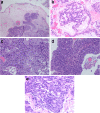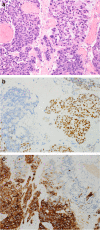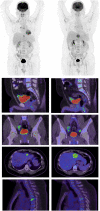Urachal mixed adenocarcinoma and small cell neuroendocrine carcinoma with widespread metastasis and resistance to chemotherapy: a case report
- PMID: 38877561
- PMCID: PMC11177430
- DOI: 10.1186/s13000-024-01490-5
Urachal mixed adenocarcinoma and small cell neuroendocrine carcinoma with widespread metastasis and resistance to chemotherapy: a case report
Abstract
Neuroendocrine carcinoma arising from the urachus is extremely rare. We describe a case of a 33-year-old gentleman who presented with hematuria and diagnosed to have a composite adenocarcinoma and small cell neuroendocrine carcinoma arising from the urachus. The patient also had widespread metastasis at the time of presentation, therefore, he was referred for chemotherapy. However, the disease showed progression despite treatment. Recognition of neuroendocrine carcinoma component in urachal tumors, although rare, is very essential as this histologic type carries poor prognosis with aggressive clinical outcome.
Keywords: Adenocarcinoma; Chemotherapy; Metastasis; Small cell neuroendocrine carcinoma; Urachus.
© 2024. The Author(s).
Conflict of interest statement
The authors declare no competing interests.
Figures



Similar articles
-
[Neuroendocrine small-cell bladder cancer: our experience].Urologia. 2010 Oct-Dec;77 Suppl 17:64-71. Urologia. 2010. PMID: 21308678 Review. Italian.
-
High-grade neuroendocrine carcinoma of the urachus-report of 3 cases.Hum Pathol. 2017 Sep;67:126-133. doi: 10.1016/j.humpath.2017.08.003. Epub 2017 Aug 18. Hum Pathol. 2017. PMID: 28823575
-
Urachal carcinomas of the nonglandular type: salient features and considerations in pathologic diagnosis.Am J Surg Pathol. 2012 Mar;36(3):432-42. doi: 10.1097/PAS.0b013e31823fe49c. Am J Surg Pathol. 2012. PMID: 22301493 Review.
-
Primary MiNEN of the urinary bladder: an hitherto undescribed entity composed of large cell neuroendocrine carcinoma and adenocarcinoma with a distinct clinical behavior : Description of a case and review of the pertinent literature.Virchows Arch. 2021 Jul;479(1):69-78. doi: 10.1007/s00428-021-03023-7. Epub 2021 Jan 17. Virchows Arch. 2021. PMID: 33454836 Free PMC article. Review.
-
Primary metastatic neuroendocrine small cell bladder cancer: a case report and literature review.Urol Int. 2012;88(3):365-9. doi: 10.1159/000335141. Epub 2012 Jan 10. Urol Int. 2012. PMID: 22236613 Review.
References
Publication types
MeSH terms
Supplementary concepts
LinkOut - more resources
Full Text Sources
Medical

